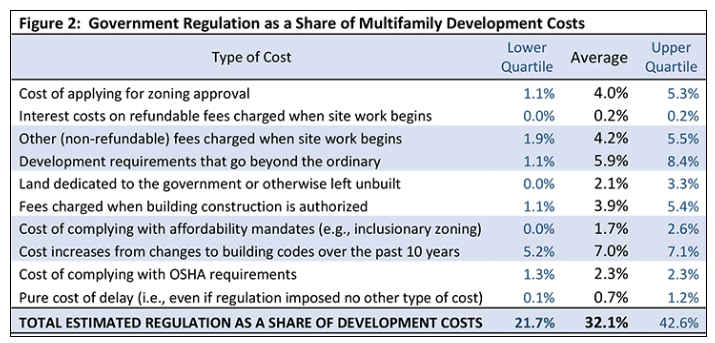Despite the Trump administration's ongoing regulatory rollback, government regulations still make up more than 30% of the cost of multifamily building, according to a newly released study from the National Association of Home Builders and the National Multifamily Housing Council.
According to the report, 90% of multifamily developers incur costs from delays caused by long approval processes, stringent construction requirements, building code changes and OSHA requirements.
These costs come from various governmental sources and range from zoning requests and affordable housing requirements to community fees such as utility hook up and impact fees.
The report breaks down costs by type, rate of occurrence and average cost in the chart below.
(Click to enlarge. Courtesy of NAHB and NHMC)
According to the report, building code changes over the last decade are the biggest inflator of prices. These costs represent 7.2% of the cost in 98% of developments.
The second highest cost is out of the ordinary development requirements, representing 6.3% of the budget for 95% of projects. The bulk of these costs come from energy-efficiency requirements. The NMHC and NAHB point to manufacturers pushing for additional regulations that would benefit their product lines as one of the reasons they resist some of the proposed changes to the International Energy Conservation Code.
NAHB representatives have criticized federal agencies for supporting certain code changes that removed flexibility and limited builders’ options, saying that they are driving up costs without improving energy efficiency to the benefit of certain product manufacturers.
The total cost of regulations on multifamily developments comes out an average of 32.1%, with the low end of the spectrum of regulatory expenses representing 21.7% of costs and the high end representing 42.6% of the costs (see chart below).
(Click to enlarge. Courtesy of NAHB and NHMC)
Though not against regulation on the whole, NAHB and NHMC feel that the heavy regulatory costs are exacerbating the affordability issue and advocate an assessment of what is necessary to regulate and what is not.
From the report:
When the cost of multifamily development rises, it unavoidably translates to higher rents and reduced affordability of rental housing. Multifamily developers can not secure financing to build their projects unless they can demonstrate to lenders that the rents will be sufficient to cover costs and pay off the loans. The purpose of this article is not to argue that all regulation is bad and should be eliminated, but to raise awareness of how much regulation currently exists, how much it costs, and to encourage governments to do a thorough job of considering the implications for housing affordability when proposing and implementing new directives.







